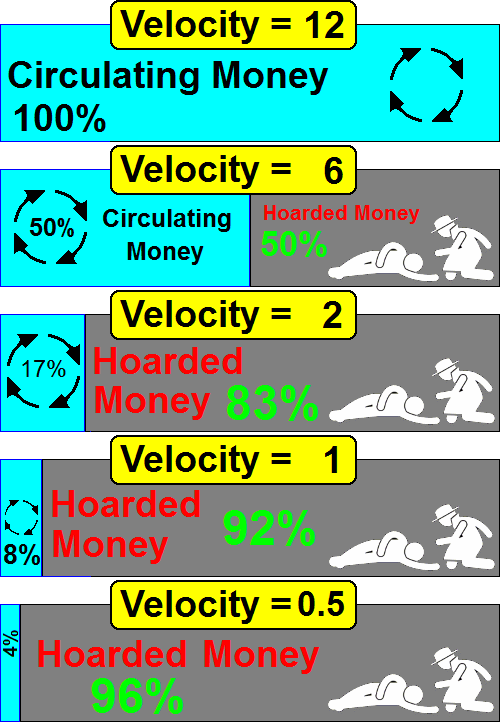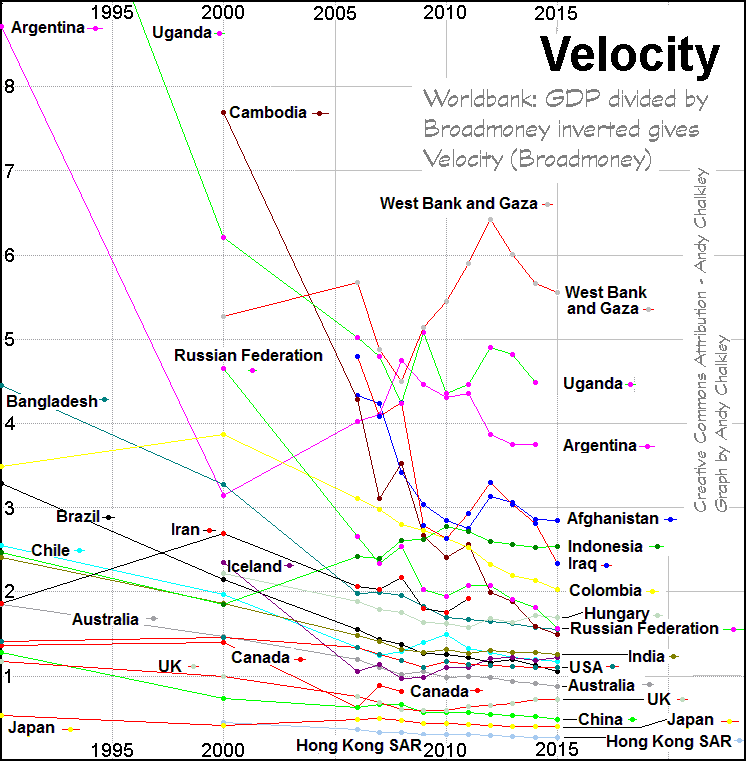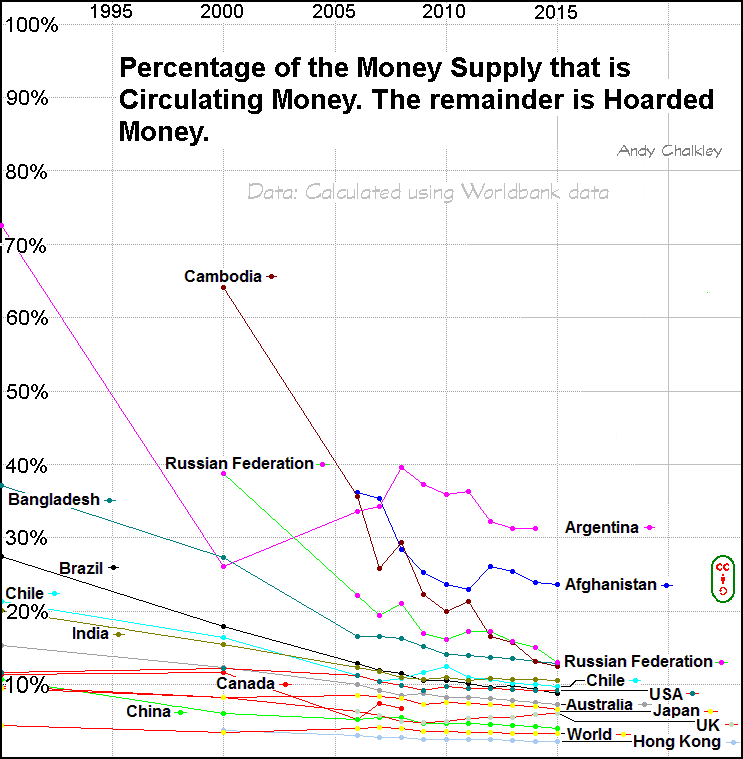
I have identified a few items that enabled us to move from our life as hunter-gatherers to a civilised life. These include:
All the above items and more are required to operate a society. Failure of any of the above will push society into crisis or collapse or disappearance. However, nothing will cause collapse quicker than a collapse of the money system. The inefficiency of barter becomes rapidly apparent. Trade between strangers becomes impossible of difficult. Division into tribal groups occurs. These groups attack each other and civilised order disappears. Money-system-collapse destroys society more effectively than war and far more effectively than breaking the other items listed above. We need a highly ordered society to operate with a money system. For most of our existence as humans we existed as hunter-gatherers. For less than one percent of our existence, we have lived a civilised life. We are still in the experimental stage of the setup of civilisation and we are still making mistakes and one of the mistakes is the hoarding of money. Hoarding was difficult as hunter-gatherers particularly for nomadic people but it has become a competitive evil in our current age and the effects of the hoarding are little studied.
So let us start by going back and study a likely transition from a hunter-gatherer life in an early village. You are an egg seller who lives near a carrot seller. I am the strongman of the village. For many years, you have been exchanging eggs for carrots and other goods. Or you perhaps you were giving away eggs in great numbers and occasionally receiving a carrot or two. These methods were inefficient and time-consuming. You often had little else to eat except eggs. I create some tokens and enforce their use as money. You now exchange eggs for tokens rather than exchanging them for carrots and whatever else. You now have a plentiful variety of food and manage to sell all that you produce. Your egg production rises, as does carrot production. I issue more tokens to match the increase in trading activity. I create the tokens at no cost and issue new tokens approximately in proportion to the increase in trade. I repeat “I issue new tokens at no cost.”
Now I pose a question. How long would you, the egg seller, hold the tokens? When I ask this question, people answer with figures of between one and seven days. This equates to a velocity of either 365 or a slower 52 transactions per year. In our new society, we have a velocity of between 365 and 52. You may notice that there is a big difference between these velocities and typical modern velocities of 1 or 2. Money in current society only changes hands once or twice a year. Money is not moving as it does in our ancient village study.
Back in our ancient village, our onion seller decides he will store tokens for a ‘rainy day’. He has created a problem. Some money tokens cease to circulate. They have become hoarded. Circulating Money has become Hoarded Money and business falls. You have difficulty selling eggs because, to use a common phrase, ‘no-one has any money’. I decide to release more tokens to lift the Circulating Money component of the Money Supply and restore trade. I release a number of tokens to equal what I perceive to be the volume of tokens that have been hoarded. Trade improves. So here we have our first observation of hoarding of money and its effect.
I call the hoarding of money ‘a misuse of money’. A few weeks later, our onion-selling hoarder decides to spend the hoarded tokens back into circulation and does so all in one day. The Circulating Money increases dramatically in one day creating a classic inflation situation. Notice that a money inflation event has occurred without increasing the Money Supply. I thus divide the Money Supply into two components: Hoarded Money and Circulating Money. As the onion man spent his Hoarded Money into circulation, the Hoarded Money has decreased and Circulating Money has increased. Hoarded Money was converted into Circulating Money. Thus, we need a way of determining what proportion of the Money Supply is Hoarded Money and what proportion is Circulating Money. We need to work out how long money is typically held before being used for a transaction. This is tricky and I made an executive decision so that I could make calculations. I give you a quick run through of my thinking. A typical employee is likely to have spent his (or her) wage within one week. A fruit shop restocks daily. To enable a calculation I have chosen a cut-off point of one month. Any money held for more than one month is deemed to be hoarded. It is an arbitrary figure, but it allows a calculation. It equates to a velocity of twelve. If money is only held for one month, it changes hands and enables twelve transactions in one year. Or in reverse: when we have a velocity of 12, money is changing hands once each month. These are averages and so it is not quite correct to say that money is changing hands in less than a month. However, using a figure of one month gives convenient results. When we have money changing once each month, I can state that:

In a country with a velocity of two, money is changing hands twice each year on average. By my calculations, one-sixth of money is Circulating Money and five-sixths is Hoarded Money.

In a country with a velocity of one, money is changing hands once each year on average. By my calculations, one-twelfth of money is Circulating Money and eleven-twelfths is Hoarded Money.

In the carrot and egg example, it is not the total volume of tokens that influences trade, it is the volume of tokens that are in Circulating Money. It is wrong to say the economy depends on the Money Supply alone. It depends on Money Supply AND velocity. You can say that the economy depends on ‘Money Supply and velocity’ or you can say that the economy depends on Circulating Money. To study the Circulating Money is essential to the understanding of the mechanics of maintaining a money system. I now give you a table of equivalents. It is fairly easy to comprehend that a velocity of one is equivalent to a Hoarded Money percentage equal to ninety-two and a velocity of 12 is equivalent to a Hoarded Money percentage equal to zero.
| Velocity | Circulating Money | Hoarded Money |
| 12 | 100% | 0% |
| 10 | 83% | 17% |
| 5 | 42% | 58% |
| 3 | 25% | 75% |
| 2 | 17% | 83% |
| 1.5 | 12% | 88% |
| 1 | 8% | 92% |
| 0.75 | 6% | 94% |
| 0.5 | 4% | 96% |

And:
Here are some typical velocity graphs:








Modern money commonly changes hands twice a year (or less) which is expressed as: Velocity equals two. The reason is that we are not using money for its intended purpose. We are hoarding it rather than using it for its original purpose. Just as in the village, the practice of hoarding tokens inhibits transactions involving eggs and carrots. In our society, hoarding damages the Real Economy. Possession limits growth. The carrots and eggs section of the economy can be classed as the Real Economy. In the modern economy, almost all money is hibernating. Out of interest, Hoarded Money has no value. When money is hoarded, a similar amount has to be introduced into circulation to prevent a shortage of money. If hibernating money is brought back into circulation, an equal amount of Circulating Money needs to be removed to prevent an inflationary event. I shall explain this more clearly in other chapters. Just imagine that, in our modern world, all the money in tax havens was suddenly spent into the real economy! The effect would be catastrophic. Thus I say that: “The money in tax havens has no value.” It is actually a stack of virtual money waiting to cause a hyperinflation. If you wanted to design a hyperinflation event, you would allow vast quantities of money to be hoarded, then trigger the hoarders to spend their hoards all at once. Our society will not be destroyed by a nuclear explosion but by a financial Armageddon. The enemies will trigger a financial collapse by triggering the spending of Hoarded Money. This could be by forcing tax haven money into circulation.
In the modern world, we manipulate the use of money so much and put so much human effort into its manipulation that we watch our Real Economy get destroyed. We import food and goods and watch our industry collapse whilst an army of financial advisers fight to tell us how to make ‘more money from money’. Those that make money from money are considered to be clever rather than parasitic. If traders in the real economy have no money with which to trade, there is no economy. The vultures would destroy our real economy industries just to make an addition to their hoards.
Money is imperfect because it not able to act as a store of value at the same time as enabling transactions. Money was invented to facilitate transactions and so it needs to act as a temporary store of purchasing power between transactions, but it does not need to hold value any longer than the next transaction. It is better that it holds its value so that someone down the line does not lose out on purchasing power. A coupon, for example, only holds its value until it is redeemed. I take you back to our village of old not long after we came out of our hunter-gather stage. This can be approximated to about 12 000 years ago and this is less than 1% of the time since humans started to move out of Africa around 2 000 000 years ago. [12 000 divided by 2 000 000 = 0.6%] Civilised society was formed by about 5 000 years ago, which is 0.25% of the time since humans started to leave Africa. Civilisation and money are very new to humans and the understanding of the operation of money systems can be assumed to be in its infancy. At the 99.75% point on the human existence timeline, we invented the money token system to facilitate transactions. We have used money tokens for less than one percent of the duration of our human existence. Money tokens were invented to enable transaction efficiency, not to enable hoarding. Only those without an understanding of money systems would hoard money. The hoarding of money is completely at odds with the conception of a money system as an essential for civilised society. Instead of swapping eggs for carrots, we swapped eggs for a universal token, then walked across town and swapped the tokens for carrots. Humans soon established typical mutual exchange values which we call ‘price’ and so items have a value measured in tokens. So the very nature of money and the operation of the human mind establishes a value or ‘price’ for items measured in money tokens. Rarely does a formal authority dictate the exchange rate between goods and money and attempts to do so are invariably a failure. The human mind is remarkably capable of setting prices and values. Ask someone what something is worth and they mentally deliberate and confidently state the ‘value’ of an item. “The house is worth $235 000.” Humans mentally calculate the value to around five percent quite rapidly and accurately whilst taking into account numerous flexible variables.
Now that our village has a common unit, accounts can be created in this common unit of account. This method of mutual exchange is a far superior method of trading that overcomes the inefficiencies of the barter system and enables trade between strangers. (We were more likely to have had a ‘giving’ system before the money-token system rather than the common belief that it was a barter system.) Money enables efficient transactions and enables us to set ‘values’ in the marketplace. To do so, money acts as a temporary store of value. The process works well until someone holds onto the tokens for too long to use them as a store of value for future use. This hoarding inhibits the exchange of eggs for carrots. We now have the first imperfection of money:
The tokens only need to maintain value for as long as a typical exchange occurs. It turns put that the average time taken to the next transaction is critical to the operation of money. One of our problems is that money retains value better than most of the goods that it can be exchanged with. Thus money is preferred to goods. Where an excess of individual enterprise exists, the excess tends to be stored as money rather than goods because it holds value better than goods and is more readily converted to goods or services in the future. The cure is to ensure that money loses value at a similar or faster rate than goods. This can be encouraged through inflation or demurrage.
Another benefit of the use of tokens is that multiple transactions occur with one token over the course of one year. This gives a benefit to a society of many times the face value of the token. Tokens benefit society most when they constantly move. The faster they move the more they benefit the society.
The money token system has beautifully evolved from the exchange of carrots, eggs and apples in a village. The inventive human soon developed methods to manipulate the token system for personal advantage:
Usury turns out to be impossible and necessary at the same time. The debts are impossible to repay whilst the loans are needed to enable business. It is one of the great conundrums of the last five thousand years which has yet to be solved. I add my two cents to the solving of the conundrum. Business needs money before it can make money. The relaxation of the rules on usury over the last three centuries has unleashed immense productive effort and progress whilst creating a total world debt that exceeds the volume of money in the world by a factor of two. We can live with the debt. We can live with impossible debt, but we cannot live with collapse. More on this as we travel through these pages.
Such is the inventiveness of the human. In the modern world, there are whole segments of society dedicated to ‘making money from money’. All this effort is outside the egg-and-carrots real economy. I am going to pre-empt the next messiah and declare all these ‘money-from-money’ practices to be evil. I declare the activity of ‘making money from money’ to be an evil practice.
As is said in the first line of this chapter: “nothing will cause a breakdown and collapse society of quicker than a collapse of the money system.” At the time of the collapse of previous money systems, it is not the inability of production that causes a collapse, nor is the willingness to purchase goods. It is bad management and poor maintenance of the money token system that causes the collapse. The hoarding of money plays a significant part in this, as does the level of debt to money.
Next, onto the flow of money.